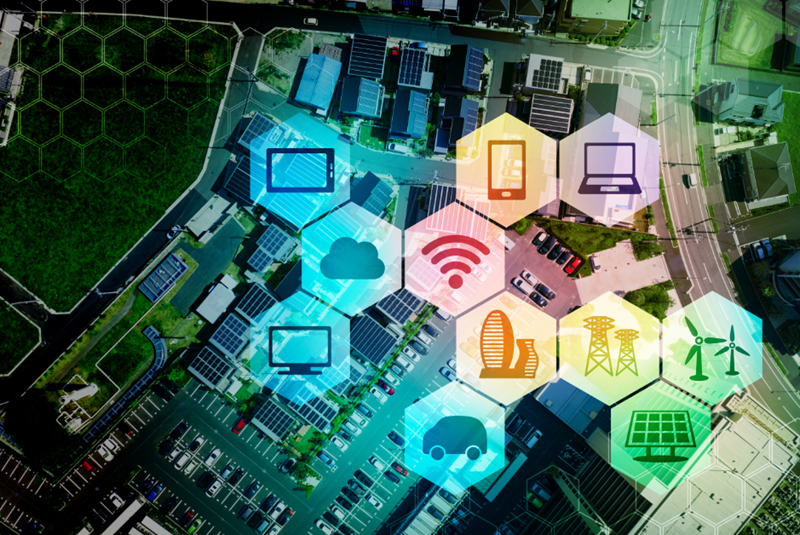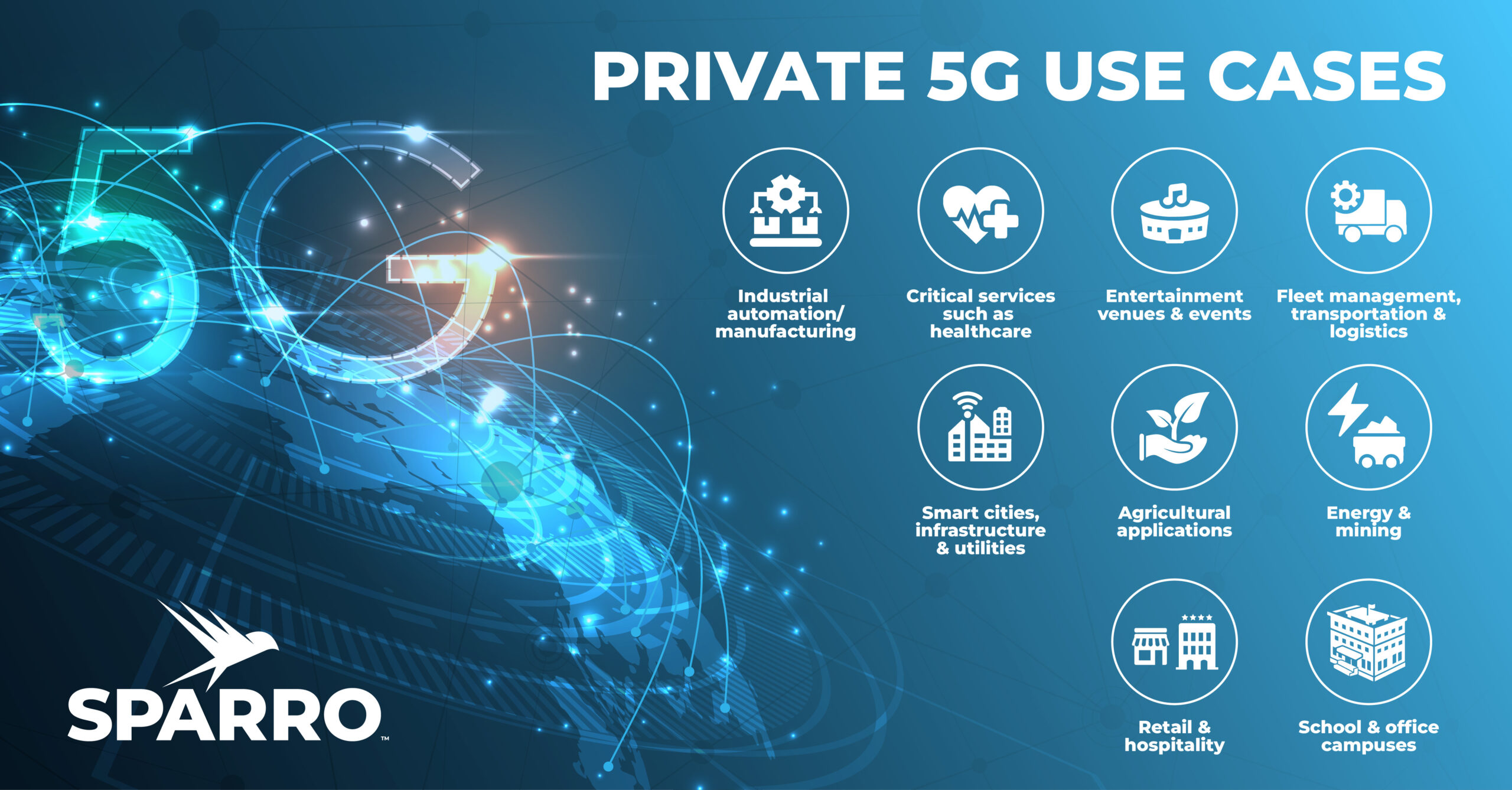Table of Contents
- What is private 5G?
- What benefits does private 5G have over WiFi?
- What are some use cases for private 5G?
- What do you need to watch out for when adding a private 5G network?
- Here are some helpful links to learn more
What is private 5G?
Most people are aware of 5G networks, the fifth generation of cellular networks designed for communication using mobile devices. Devices on 5G networks function according to specific technology standards. They are often subject to regulatory oversight of their use of the wireless spectrum. Such networks are widely available and are generally accessible for public use.
A private 5G network functions similarly but operates in a defined area and is not publicly accessible. For example, it might cover an industrial facility, a business or educational campus, or an airport. Only authorized users can access the network, and coverage is limited to the extent of the private network’s infrastructure.
Private 5G networks are typically deployed where a specific use case is not well-served by public 5G or WiFi. A facility may need greater security, or a large number of devices may require low latency and high throughput.
Often, an organization will work with a cellular provider to obtain wireless spectrum and the necessary equipment to access it. Different configurations are possible, including standalone, hybrid, and sliced private networks. In each case, there is often some method for handing off traffic from the private 5G network to other networks for seamless communication.
What benefits does private 5G have over WiFi?
Private 5G can be more expensive to implement than WiFi, primarily due to infrastructure costs. However, with a large industrial shift, OEM manufacturing efforts, and product designs, costs for a private 5G network have decreased significantly and, in some use cases, are comparable to the cost of deploying WiFi.
With this investment, private 5G solutions offer many benefits, including:
- Faster speeds and lower latency – With faster data transfer speeds and lower latency, 5G technology can better support real-time applications and critical communications.
- Greater capacity – 5G networks can accommodate a far larger number of devices than WiFi. These features provide better support for applications such as Internet of Things (IoT) solutions and edge computing.
- Improved reliability and Quality of Service (QoS) guarantees – Similarly, 5G offers greater reliability, especially in high-density environments, making it more suitable for critical applications.
- Improved security – Private 5G networks typically implement enhanced security features than WiFi networks, including stronger encryption and authentication. They also generally incorporate more robust access controls and other protections, such as to protect against DDoS attacks and malware.
- Availability of network slicing – Private 5G networks allow for network slicing, creating isolated virtual networks within one physical network. This offers a way to separate traffic by department or application, depending on their needs for resources and security.
While private 5G networks generally operate alongside WiFi networks rather than replacing them, their benefits support a variety of use cases, including those we consider below.

What are some use cases for private 5G?
There are a wide variety of potential applications for private 5G. With faster data transmission, higher capacity, better reliability, and improved security, it can support IoT and smart solutions, AR/VR applications, and more. For applications that require critical communications and/or support for a vast number of devices, private 5G provides a high-performance option.
Industrial automation and manufacturing are perhaps the most widely implemented use cases, so we’ll first discuss that. But there are also many other use cases for private 5G, and we’ll consider a number of those below.
Industrial automation and manufacturing
Industrial automation and manufacturing are by far the areas that have seen the most widespread use of private 5G. For example, smart factories use private 5G to support massive Industrial Internet of Things (IIoT) installations, robotics, real-time inventory tracking, surveillance, and more.
The vast number of devices and the sheer amount of data provide a perfect use case for private 5G. Its low latency can yield safety improvements and better quality controls. The flexibility of wireless, combined with enhanced security, reliability, and bandwidth, supports everything from operations and production to logistics and maintenance.
Private 5G can also support the placement of factories where public connectivity would otherwise be lacking, such as in rural areas. In addition, private 5G can provide better coverage with fewer devices than WiFi. It is also less subject to interference from objects within a plant, such as steel construction materials.
Critical services such as healthcare
The use of private 5G is growing in healthcare, with more than a dozen private 5G networks being announced in the past year. The key benefit here is enterprise-level security, which is a requirement for sensitive and protected medical information. This, combined with enhanced connectivity, low latency, and support for a vast number of devices, enables many potential applications:
- Fast, secure access to medical records, imaging, and other time-sensitive protected information.
- Telemedicine, as well as healthcare outreach in rural and remote areas.
- Remote monitoring and IoT device integration, including the use of medical wearables to track vital signs and other patient data.
- Edge computing, such as for AI-enhanced diagnostics.
- Asset tracking and inventory management, such as for allocation of in-demand hospital equipment.
Private 5G facilitates the adoption of innovative technologies to improve outcomes and accessibility while streamlining operations and lowering care costs.
Entertainment venues and events
Private 5G is also experiencing growth in the entertainment space, particularly for stadiums and similar large venues. During events, the substantial number of guests texting, uploading videos, and posting selfies can overwhelm the public network. To sustain operations and provide a secure network for coaches, entertainers, and staff, private 5G offers the right solution. It can also improve security, for example, by providing a consistent channel for CCTV cameras and communication among security personnel. Its low latency also provides a reliable link in case of emergency.

Fleet management, transportation, and logistics
To enable efficient and cost-effective operation for fleets and transportation hubs, operators need to track and route vast numbers of vehicles. They also need to be able to keep those vehicles running and, in some cases, to manage conditions for transporting specific goods. Private 5G offers a secure, low-latency option to carry the vast amounts of data needed to keep operations running smoothly and safely. This is especially true in large-scale outdoor or mixed environments where WiFi isn’t always practical. Because of this, transportation and logistics operations are also seeing increased growth in the use of private 5G. Some applications include:
- Real-time tracking for route optimization, fleet usage, and scheduling updates based on live traffic conditions.
- Improved supply chain visibility, including shipment status, inventory levels, and delivery schedules.
- Inventory tracking and pick-and-pack optimization from the warehouse to the fleet, as well as IoT solutions to improve the efficiency of loading and unloading.
- Environmental monitoring, for example, cold chain monitoring using IoT devices to maintain the optimal conditions for perishable goods.
- Driver safety monitoring, such as solutions for fatigue detection and collision avoidance.
- Telematics and diagnostics for predictive maintenance, improving efficiency and reducing downtime.
- Data gathering and AI-assisted analysis to discover trends and find opportunities for improving efficiency.
- Improved communication across public and private 5G networks using the 5G-enabled phones that most employees already carry.
Private 5G supports improved fleet management & vehicle use, enabling streamlined operations, reduced costs, better safety, and improved customer satisfaction.
Smart cities, infrastructure, and utilities
Security is a primary concern for smart cities, infrastructure, and other public sector projects. Hackers can wreak havoc on critical public services using improperly secured networks. Thus, private 5G’s enhanced security compared to WiFi is a significant benefit for this use case. Encryption and network slicing can help protect public sector communications against cybersecurity threats.
Private 5G networks aren’t yet widely implemented in cities. However, they are increasingly being considered for uses such as public safety, infrastructure monitoring, and traffic management. IoT solutions combined with private 5G can support sensors in roadways and on streetlights, for example, to monitor use and improve traffic flow. Enhancements to services, transportation, and infrastructure can enable the smart cities of the future.
Utilities are beginning to use private 5G more often. In conjunction with IoT, such solutions can spot where repairs are needed before failures occur. They can also provide insight into usage and where efficiency can be improved. Other potential applications in the public sector include environmental monitoring, waste reduction, emergency response, and disaster management.
Agricultural applications
One application that is already seeing an increase in the use of private 5G is precision agriculture and smart farming. This approach uses IoT and robotics to perform routine tasks, optimize crop and livestock yields, and improve efficiency. To achieve these goals, substantial amounts of data must be collected and transmitted with high reliability and low latency.
Private 5G, often combined with AI, can help farmers use this needed data to reduce waste and better manage resources. Specific uses may include:
- Using machine-to-machine communication, GPS data, and sensors to guide robot-operated equipment such as tractors for plowing and harvesting.
- Determining how best to apply resources such as fertilizer and water to areas based on hyper-local microclimate data.
- Similarly, gather data and use AI to assess soil quality, crop health, pest damage, and other factors to determine where to plant seeds, harvest crops, or graze livestock.
- Improve worker safety by shifting dangerous tasks to drones, robots, and other autonomous vehicles.
- Implement environmentally friendly practices such as integrated pest management and automated, AI-assisted selective weed identification and removal.
- Track calving status and livestock health to reduce animal mortality, optimize feeding, and detect signs of illness.
- Monitor and adjust environmental conditions in smart greenhouses.
- Use AR to visualize planting layouts and troubleshoot equipment.
Private 5G can also help in providing connectivity to rural areas that would otherwise be inaccessible. Many rural communities, such as those where farms are typically located, have neither broadband access nor public 5G access. Private 5G can improve access to expert consultations and other information that can guide agricultural practices.
Energy and mining
The mining and energy (e.g., oil and gas) sectors are among the fastest-growing sectors for private 5G use. These industries often operate in remote areas, even underground, where running WiFi may be impractical or impossible. Private 5G networks provide a strong alternative for numerous functions, including:
- Asset tracking, such as with 5G-enabled IoT devices, to improve the allocation of valuable resources and reduce losses.
- Predictive maintenance of critical equipment to spot potential failures, perform pre-emptive repairs, and optimize maintenance schedules to reduce downtime.
- Remote monitoring and control to improve efficiency, decrease costs, and reduce the need for humans to work in high-risk situations.
- Environmental monitoring and compliance for air quality, water quality, gas leaks, seismic activity, and more.
- Worker safety monitoring, such as tracking worker locations, monitoring vital signs, and providing alerts for potential emergencies.
- Energy efficiency, such as enabling smart energy regulation solutions and finding opportunities to reduce waste.
- Real-time AI-driven analytics to optimize the use of resources and improve decision-making and operational efficiency.
Private 5G’s ability to carry large amounts of data with low latency supports safety and efficiency functions that are critical for modern energy and mining operations.

Retail and hospitality
Private 5G networks in retail environments offer benefits for both stores and shoppers:
- Better inventory management, for example, using IoT solutions and edge computing to prevent theft, keep shelves stocked, and manage orders.
- Better connectivity for shoppers to access reviews and other product information.
- Streamlined checkout processes, including mobile payments.
- Immersive augmented reality (AR) and virtual reality (VR) experiences, along with in-store navigation, real-time product availability, and other services to enhance the shopping experience.
- The ability to offer personalized recommendations to shoppers based on their actual behavior.
- Support for security and surveillance solutions to improve security and loss prevention.
Similarly, private 5G networks can support improved efficiency and security in hospitality properties, along with opportunities for more personalized experiences and smoother interactions with guests. It can enable additional guest services such as contactless payments, digital keys, virtual concierge services, and AR/VR experiences. It can also support the implementation of smart room solutions that incorporate large numbers of IoT devices.
School and office campuses
Private 5G networks haven’t yet been widely implemented on school or office campuses, but potential applications include:
- Support for virtual learning and research initiatives
- Reliable and secure connectivity for a larger number of users
- Support for IoT solutions, for example, for automation and smart building management
- Improved security and safety, for example, with AI-assisted surveillance solutions to detect potential issues and broadcast necessary information
What do you need to watch out for when adding a private 5G network?
Aside from cost, the biggest hurdle in deploying a private 5G network is the expertise required to implement it correctly. You’ll need to address many different aspects, such as:
- Spectrum licensing and regulatory requirements
- Network architecture and infrastructure
- Appropriate coverage and mitigation of interference
- Security protocols, including access controls and encryption
- Integration with existing systems, networks, applications, and devices
- Service Level Agreements (SLAs)
- Future-proofing
- Ongoing monitoring and maintenance
While it is technically possible for an organization to implement a private 5G network on its own, that’s not recommended. An expert integrator like Sparro can help you navigate the potential pitfalls and avoid costly mistakes. We can also coordinate with Tier 1 carriers and establish SLAs for better results that help achieve your organization’s goals.
Here are some helpful links to learn more
- What is private 5G?
- How private 5G helps address four major business needs
- Private 5G Networks Are On The Rise, Fueling The Industry 4.0 Drive
- Private 5G networks are gradually emerging in sectors beyond manufacturing and transport
- 8 top industries for private 5G
- Japan’s farmers are getting too old to work the land. 5G-powered smart tech is doing the heavy lifting for them.

